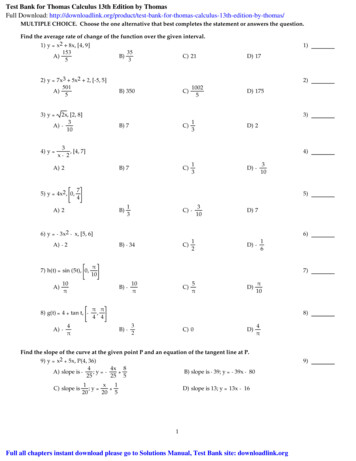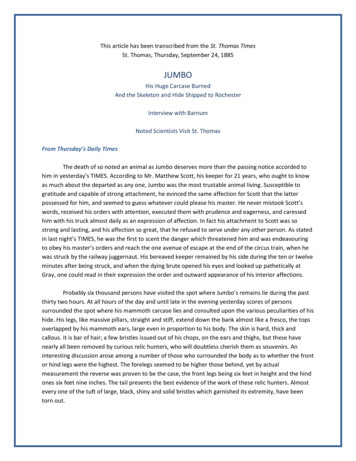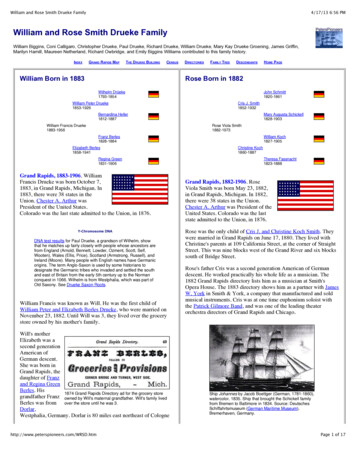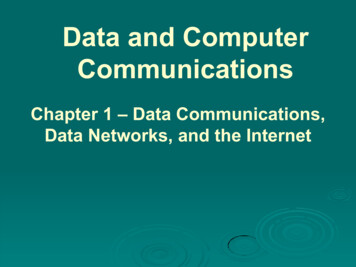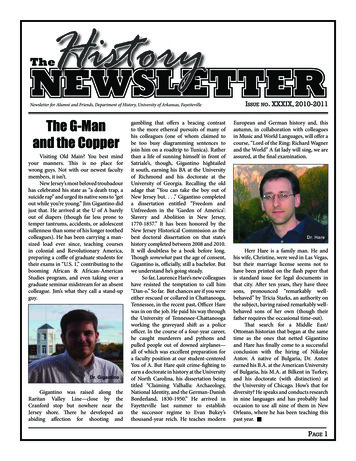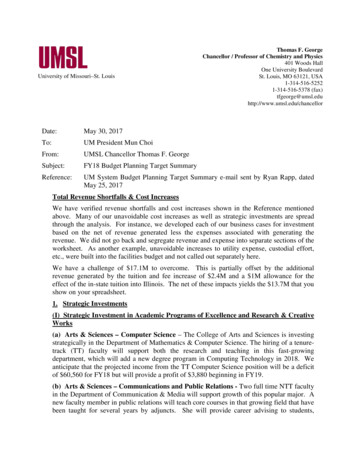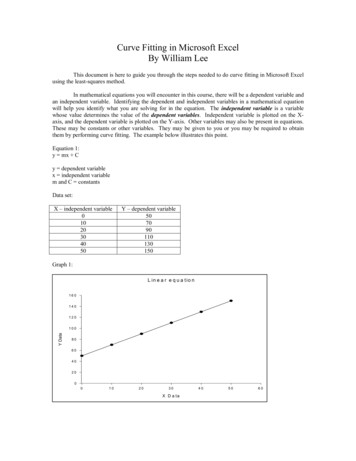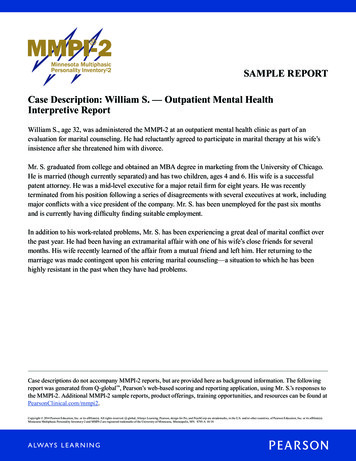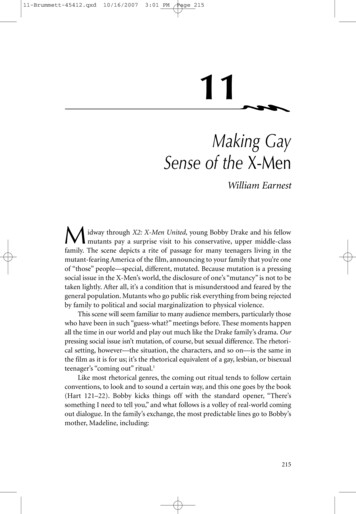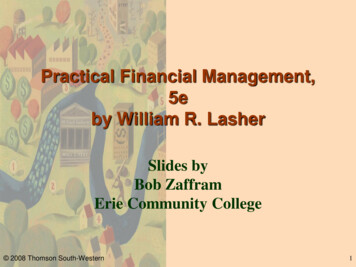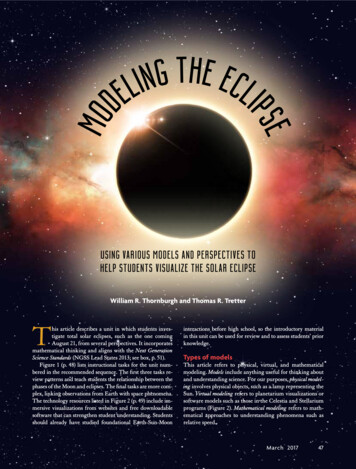
Transcription
William R. Thornburgh and Thomas R. TretterThis article describes a unit in which students investigate total solar eclipses, such as the one comingAugust 21, from several perspectives. It incorporatesmathematical thinking and aligns with the Next GenerationScience Standards (NGSS Lead States 2013; see box, p. 51).Figure 1 (p. 48) lists instructional tasks for the unit numbered in the recommended sequence. The first three tasks review patterns and teach students the relationship between thephases of the Moon and eclipses. The final tasks are more complex, linking observations from Earth with space phenomena.The technology resources listed in Figure 2 (p. 49) include immersive visualizations from websites and free downloadablesoftware that can strengthen student understanding. Studentsshould already have studied foundational Earth-Sun-Mooninteractions before high school, so the introductory materialin this unit can be used for review and to assess students’ priorknowledge.Types of modelsThis article refers to physical, virtual, and mathematicalmodeling. Models include anything useful for thinking aboutand understanding science. For our purposes, physical modeling involves physical objects, such as a lamp representing theSun. Virtual modeling refers to planetarium visualizations orsoftware models such as those in the Celestia and Stellariumprograms (Figure 2). Mathematical modeling refers to mathematical approaches to understanding phenomena such asrelative speed.March 201747
Instructional tasks1. Patterns in the lunar cycle (Earth-basedperspective)Direct observationsBegin reviewing patterns in the sky by having students document sunrises, sunsets, and Moon phases. Students can sketchin their science notebooks how the Sun and Moon move in thesky over the course of a day or night as well as the visible shapeof the Moon over longer periods. A compass (or compass app)will help them note orientation. Students will notice a patternif they make observations at the same time daily. They shouldadd predictions and “I wonder” questions and statements whenthey notice something of interest. Ask students basic formativeassessment questions such as, “In what direction does the Sunrise or set?” and “Where does the Moon rise and set?”Then, encourage students to think more deeply by askingthem, “Why do these objects rise in the east and set in thewest?” Although lunar phases and their cause are taught inmiddle school, teachers can reintroduce students to the appearance of the Moon from Earth, the phase names, and theposition of the Moon in relation to the Earth and Sun duringthe lunar cycle.Teachers can assess students’ direct observations throughtheir science notebook sketches and questions answered during class or in their notebooks.Point out that the Sun’s and Moon’s respective diameterto-distance ratios from the Earth are similar, which meansthe two appear to be about the same size when viewed fromEarth. This helps explain how the Moon just barely fullyblocks the Sun during a total solar eclipse.As an extension, students can think about the Moon slowlymoving away from Earth (at a rate of about 4 cm per year), dueprimarily to the energy drain from constant tidal pulling onEarth. Given that today, the Moon appears to be approximately4.6% larger than the Sun, students can compute how long it willtake for the Moon to move approximately 4.6% (16,700 km) farther away. This works out to about 418 million years before theMoon’s apparent size is too small to cover the Sun completely—preventing total solar eclipses from ever occurring again.Planetarium and virtual modelingA planetarium complements students’ real-world observations,allowing the educator to control variables such as time and dateto help make patterns apparent. An alternative is simulation software such as Stellarium (Figure 2), which also enables students toquickly gather data about patterns in the sky. Using a planetariumor simulation software avoids real-world observational issues suchas clouds.FI G U R E 1Overview of instructionThe recommended instructional sequence is shown numerically along with an estimated time for each modeling experience.Earth-based perspectiveSpace-based perspectiveGrounded in observation and predictable patternsthrough modeling. Includes mathematical andcomputational thinking to generate data to constructexplanations and engage in argument from evidence ofsystems and system models to understand the scale ofsize and distance.Emphasis on modeling the dynamic interactions of theSun, Earth, and Moon (rotation, revolution) throughsystems and system models. Scale of phenomena canbe emphasized.1. Patterns in the lunar cycle (monthly and annual) Lunar cycle: One month of observations andsketches of visible shape, individually or as aclass. Revisit over time so students can observe arepeating pattern of Moon phases throughout theyear.2. Earth’s rotation causes movement patterns in the sky,and the positions of the Earth and Moon relative to theSun lead to lunar phases. Identify the cause of the east-west patterns as seenfrom Earth’s surface (30 min.) Identify the cause of changing Moon phases (30min.)4. Eclipses and frequency of phenomena Identify how eclipses occur and why eclipses are not3. Solar eclipsesregular events (45 min.) Types of eclipses and when they are observable (30 Observe the movement of objects in space tomin.)identify the direction of shadow movement (30 Shadows produced during a total solar eclipse—whymin.)do they occur west to east? (45 min.)48The Science Teacher
Modeling the EclipseFI G U R E 2ResourcesPlanetarium (both Earth- and space-basedperspectives, with emphasis on the latter)The immersive environment of a planetarium isideal for engaging students in exploration of thesecomplex, large-scale phenomena. Offerings ofdifferent planetariums vary, so investigate what isavailable near your community.Eclipse simulationsEclipse of the Century: http://bit.ly/2glHDF8A video of the 1991 “eclipse of the century” filmedfrom Hawaii.Eclipse Interactive: http://bit.ly/2gc19pmStudents can manipulate size and distance toobserve both lunar and solar eclipses. Note that inthe total solar eclipse, the shadow moves from westto east across the South American continent.2017 Total Solar Eclipse: https://svs.gsfc.nasa.gov/4314This simulation allows students to view the totalsolar eclipse’s path across the United States onAugust 21, 2017. They can watch the path of totalitymove from the West Coast to the East Coast andidentify how the eclipse will look from variouslocations across the country.Solar Eclipse from Space: http://aol.it/2gDBZvHA series of photographs taken by NASA shows asolar eclipse from the space perspective, lookingtoward Earth. This shows how eclipses happenin other parts of the world and how the shadowmoves from west to east.Stellarium (free; Earth-based perspective):www.stellarium.orgThe best non-planetarium option for the Earthbased perspective. This software shows a realisticsky from any home coordinate (latitude andlongitude) you enter. The software shows what youwould see from Earth’s surface if you could haveunobstructed sightlines. It is possible to set up andobserve eclipses.Celestia (free; space-based perspective):http://celestia.sourceforge.netThis software allows you to fly throughout the solarsystem and beyond the galaxy.2. Earth’s rotation causes movement patternsin the sky, and the positions of the Earth andMoon relative to the Sun lead to lunar phases(space-based perspective).Physical modelingStudents can create physical models that help them understand the patterns they noticed in the first task. As describedelsewhere (e.g., Kruse and Wilcox 2009; Schatz and Fraknoi2016; Taylor 1996), a basic model that uses a lamp to represent the Sun, students’ heads to represent Earth, and a foamball to represent the Moon can model motions and interactions so that students can make predictions.Students often struggle with the direction of the Earth’srotation. Have students hold a transparency of the outline ofthe United States in front of their face and look out into space(toward the lamp/Sun). Through observations and questions, guide them to understand that Florida is on the left earbecause they are looking out from inside the Earth. Thus,students discover that they should rotate their left shouldercounterclockwise (from the perspective of the North Pole).To determine the direction of the Moon’s orbit around theEarth, students must first understand the origin of the EarthMoon system. Approximately 4.5 billion years ago, a shockwavein space set our young solar system—mostly a cloud of gas anddust—into motion. As it gained momentum, the dust flattenedinto a disk. Over hundreds of millions of years, the planetsformed and inherited their motion from the early solar system.According to the favored scientific hypothesis, the Moon thenformed from a collision between our planet and a Mars-sizedprotoplanet named Theia. This collision released large amountsof material from the early Earth, which swirled around in thesame direction as Earth’s rotation and then coalesced into ourMoon (Mackenzie 2003). Students should model the Moon’sorbital revolution in the same direction as the Earth’s rotation.Later, this will help explain why the shadow of the total solareclipse moves from west to east.Planetarium and virtual modelingIn a planetarium or using the software simulation Celestia (Figure2), students can see the rotation of Earth while hovering in space,looking back at our planet. Students note the day/night cycle asEarth rotates, including the fact that the Eastern United Statescomes into sunlight first (because the Sun rises in the east). Being“inside” the model strengthens one type of student thinking, andshifting perspective to outside the model, from afar, helps studentsthink about the phenomenon in another way.3. Solar eclipses (Earth-based perspective)Physical modelingStudents can use a revised physical model from the previoustask to construct explanations for eclipses. As students lookinto “space,” they should notice that the Earth, Moon, and SunMarch 201749
FI G U R E 3NASAPath of the August 2017 eclipse shadow across the United States.can be aligned to depict the various Moon phases. Ask studentsassessment questions: “When would solar or lunar eclipses occur [and have students demonstrate with the model]?” “Howoften do total eclipses occur?” “Why don’t eclipses happentwice every month?” Highlight the fact that all models havelimitations, such as the physical model incorrectly suggestingthat a lunar and solar eclipse occur every month.To clarify eclipse events, introduce into the model thescale of the diameters and distances in the Earth-Moon-Sunsystem. On this scale, if students’ heads represent Earth, theSun would be over 2 km away and 21 m in diameter (yourthumb held at arm’s length would easily cover it up; students will have to imagine this part of the model). The Moonwould be a tennis ball about 6 m away from the Earth/head,and it too could be covered by a thumb held at arm’s length.Students can also compare the actual numbers: Although theMoon is about 400 times smaller than the Sun, it’s about 400times closer to the Earth than the Sun and can therefore, attimes, block our view of the Sun from Earth.It helps to add to the model the 5 tilt of the Moon’s orbitrelative to the ecliptic plane; at 6 m away, 5 means that theMoon is about 0.5 m higher than the Earth-Sun line. Takingthe model outside helps students better grasp this concept.Set up the model and identify a six-story building (or a tall50The Science Teachertree) about 2 km away to represent the Sun. Using these scalesand the tilt of the Moon’s orbit, students can see why an exactalignment that leads to a total solar eclipse is relatively rare.4. Eclipses and frequency of phenomena(space-based perspective)Physical modelingBecause the student’s body often blocks light from the “Sun,”some students have difficulty understanding why eclipsesdon’t occur every lunar cycle. To help, remove students fromthe model by putting the Moon on a stick or wire and useanother foam ball on a stand, instead of a head, as the Earthmodel. Then, students can move the Earth and Moon whilekeeping their bodies out of the light.If in this model students don’t rotate the Earth, they maynotice that the Moon’s shadow moves from west to east on theEarth. This may lead to a question about how a real eclipseshadow moves, once Earth’s rotation is taken into account.Looking at the August 2017 eclipse path across the UnitedStates (Figure 3) may make students wonder why the solareclipse shadow moves from west to east, because the apparentmotion of objects in the sky is east to west. Using a mathematical model can answer the question.
Modeling the EclipseConnecting to the Next Generation Science Standards (NGSS Lead States 2013).StandardHS-ESS-1: Earth’s Place in the UniversePerformance ExpectationThe chart below makes one set of connections between the instruction outlined in this article and the NGSS.Other valid connections are likely; however, space restrictions prevent us from listing all possibilities. Thematerials/lessons/activities outlined in this article are just one step toward reaching the performance expectationlisted below.HS-ESS1-4. Use mathematical or computational representations to predict motion of orbiting objects in the solarsystem.Specific connections to classroomactivityDimensionName and NGSS code/citationScience andEngineeringPracticesDeveloping and Using ModelsStudents use models of Earth-SunDevelop a model based on evidence to illustrate theMoon interactions to observe how andrelationships between systems or between components when eclipses can occur.of a system.Students use computations frommodels of interactions of the Earth,Using Mathematical and Computational ThinkingUse mathematical or computational representations of Sun, and Moon, including spatial scalephenomena to describe explanations.(sizes, distances), to explore eclipsesand related phenomena.Engaging in Argument From EvidenceEvaluate evidence behind currently acceptedStudents use evidence to argue theexplanations or solutions to determine the merits ofrarity of eclipses from observations andarguments.mathematical calculations involvinginteractions in space.DisciplinaryCore IdeaHS-ESS1.B: Earth and the Solar SystemKepler’s laws describe common features of the motionsof orbiting objects, including their elliptical pathsaround the Sun.Students use models to explore howthe orbital motions of the Earth, Sun,and Moon lead to the phenomenonof solar eclipses. These models set thestage for students to explore Kepler’slaws in extension activities.CrosscuttingConceptsPatternsEmpirical evidence is needed to identify patterns.Students use a physical model toobserve the patterns that occur inspace.Scale, Proportion, and QuantityAlgebraic thinking is used to examine scientific dataand predict the effect of a change in one variable onanother.Systems and System ModelsWhen investigating or describing a system, theboundaries and initial conditions of the system need tobe defined and their inputs and outputs analyzed anddescribed using models.Students explore how the scale of theEarth-Sun-Moon system leads to thephenomenon of eclipses but only onan intermittent schedule. Students alsoinvestigate how the difference betweenrotational and linear speed betweenthe Moon and Earth’s surface accountfor the west-to-east movement of atotal eclipse shadow.Students use a physical model todemonstrate how eclipses occur dueto the interactions between the Earth,Moon, and Sun.March 201751
Modeling the EclipseFI G U R E 4Mathematical calculations of linear speed.ObjectDiameterCircumference(2pr or pd)How many km in one day(divide by 28 days)How many km each hour?(divide by 24 hours)Earth’s surface at theequatorMoon’s orbitaldiameter12,742 km40,030 km**1,668 km/hr726,600 km2,282,681 km81,524 km3,397 km/hrMathematical modelingThe Earth has a greater angular velocity than the Moon’sorbital velocity as seen from Earth. The Earth rotates 360ºin one day, compared to the Moon orbiting 360º in approximately 28 days.However, the Moon’s shadow, which is projected on theEarth during a solar eclipse, moves at a speed related to theMoon’s linear velocity compared to the linear velocity of theEarth’s surface. Imagine a car moving at 90 km/hr passing a truck moving at 80 km/hr. If the Sun casts the car’sshadow on the side of the truck, that shadow would movealong the truck at a speed that is the difference between thespeeds of the two vehicles (10 km/hr in this example). Forthe Moon and Earth, NASA reports the Moon’s linear velocity as 3,400 km/hr and the Earth’s surface at the equatoras 1,670 km/hr, which means that the lunar shadow movesat approximately 1,730 km/hr from west to east at the equator (Young 2006).Students can make these computations for themselves,calculating the circumference (2πr or πd) for the Earth andMoon and kilometers traveled per rotation or revolution(Earth rotation 1 day, Moon revolution 28 days). Next,students calculate how many kilometers the Earth and Moontravel in one day, which can then be converted to the distanceeach travels per hour (Figures 4 and 5). This is a necessaryconversion for a direct linear velocity comparison because thetotal solar eclipse will cross the United States in a matter ofhours (Figure 5).To compute eclipse shadow speeds at Earth latitudes other than the equator, students must calculate, using sphericalgeometry, the smaller circle traveled at these other latitudes over the course of a day and use that smaller Earthsurface speed in computations.Planetarium and virtual modelingIn a planetarium or using simulation software, studentscan observe an eclipse from Earth and then “fly” intospace and view the same event from a space perspective.This allows students to consider the tilt of the Moon’s orbit through reorienting their perspective, and the objectscan be represented to scale on the planetarium dome.These technology-enabled models incorporate correctspatial scale, orientations, rotation, and revolution, andthe tilt of Earth’s axis and the Moon’s orbit relative to theplane of the ecliptic. From these observations, studentscan construct explanations for the direct observationsthey make and experience firsthand on Earth. William R. Thornburgh (wrthor01@louisville.edu) is a doctoralstudent in science education and former planetarium educator at the University of Louisville planetarium, and ThomasR. Tretter (tom.tretter@louisville.edu) is a professor of scienceeducation and the University of Louisville planetarium director in Louisville, Kentucky.ReferencesKruse, J., and J. Wilcox. 2009. Conceptualizing Moon phases:Helping students learn how to learn. Science Scope 32 (5):55–59.Mackenzie, D. 2003. The Big Splat, or How Our Moon Came toBe. Hoboken, NJ: Wiley.NGSS Lead States. 2013. Next GenerationScience Standards: For states, by states.Washington, DC: National AcademiesFI G U R E 5Press.Mathematical calculation of the lunar shadow.Schatz, D., and A. Fraknoi. 2016. Solar science:Exploring sunspots, seasons, eclipses, and more.Moon’s orbital linear speed (km/hr) – Speed of the lunarArlington, VA: NSTA Press.Earth’s linear speed at the equator (km/hr) shadow (km/hr)Taylor, I.J. 1996. Illuminating lunar phases.3,397 1,668 1,729The Science Teacher 63 (8): 39–41.Young, A. 2006. Sun–Earth day: Frequentlyasked questions. http://go.nasa.gov/2jj9qV6.52The Science Teacher
observe both lunar and solar eclipses. Note that in the total solar eclipse, the shadow moves from west to east across the South American continent. 2017 Total Solar Eclipse: https://svs.gsfc.nasa. gov/4314 This simulation allows students
